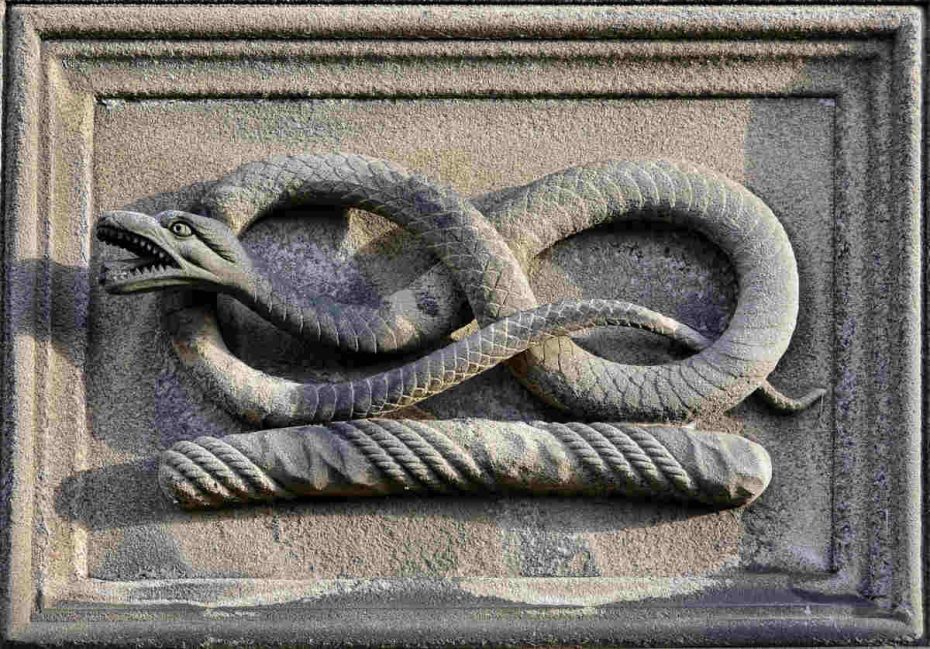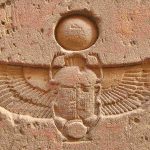The serpent is one of the most challenging religious symbols to comprehend. It has been used throughout history in all regions of the world, yet it has always had a dual meaning. It has connections to both good and evil, showing up as both the illuminator and the tempter.
The serpent is frequently depicted standing upright with legs in ancient Egyptian papyri, but there is an old tradition that says that when it defied the gods, its legs were taken away, making it crawl on the ground and eat dust. Nonetheless, it was closely identified with the ruling dynasty, and the Pharaohs of Egypt, both male and female, bore the Uraeus, or serpent decoration, on their foreheads as emblems of supremacy.
Their funeral art also features the winged serpent or seraph. The caduceus of Hermes and the serpent-wrapped staff of Asclepius reflect the mindset of the Greeks, who also assigned a large snake to protect the golden apples of Hesperides.
In India, the Naga, also known as the hooded snake, is a common symbol in both Hindu and Buddhist art. The hooded cobra, which is often represented with seven heads, overshadows Indian divinities, who are shown standing or seated. During the Night of the Gods, which separates the periods of cosmic manifestation, Vishnu sleeps atop the seven coils of the Serpent of Cosmic Time. Buddha and his Bodhisattvas are frequently represented in Khmer art as reclining in meditation atop the coils of a snake, its rising head providing a type of nimbus and canopy over them.
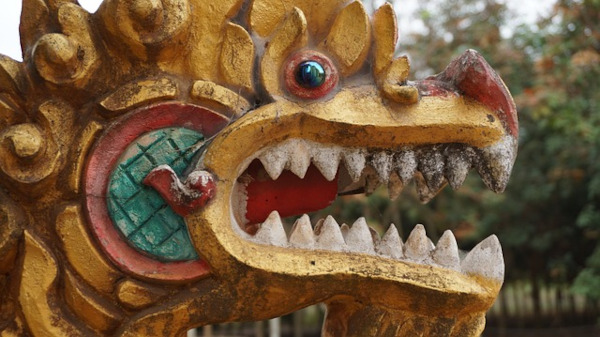
Serpent balustrades climb upward to the temples, and traditional serpent patterns are commonly encountered. The Mayas and other Central American peoples chose rattlesnakes when creating columns to support the fronts of temples and other public structures.
On the Kukulkan pyramid at Chichien Itza, there is a serpent balustrade. These serpent symbols were carried over from the Toltec civilization into the later artwork of the Aztecs of Mexico’s valley. Mexico’s national emblem is an eagle holding a serpent in its beak.
The serpent and the feathered snake image are both important sacred symbols among the Amerindians of the American Southwest. The serpent was the earth-god’s messenger to them, and their rites, such as the snake dance, are well known to anthropologists.
The Hopis believe that there are deities who reside above the clouds. People send messages to these gods through the thunderbird, which flies up to the spirit world in the sky. The phoenix, of course, is the thunderbird. The serpent serves the same purpose by delivering messages from people down into the underworld, where divine entities must be appeased.
The serpent is the earth-mother’s servant, and following the snake dance, these reptiles are freed to find their holes and go into the ground.
By accumulating observations on numerous cultures’ beliefs, we must conclude that the serpent frequently signifies the protector or guardian. The cultural heroes of Central America are known by numerous names that associate them with serpents. In the languages of the Aztecs, the Mayas, and the Quiches, Quetzalcoatl, Kukulcan, and Gucumatz all denote feathered serpents.

The Maya empire’s kings and heroes are depicted with a great winged serpent hanging above them, much like the Hindu gods. It can only be assumed that the serpent ornamented with quetzal bird plumes was naturally connected with the idea of wisdom. The pre-Aztec people were introduced to civilization by the feathered snake known as Quetzalcoatl (meaning “precious serpent”).
He gave them the calendar, trained them in law and medicine, taught them the arts and sciences, and founded their religion. He was a magnificent and noble being who was well-admired. His cult’s priests were frequently referred to as “serpents,” and the subterranean temples where their religious mysteries were conducted were referred to as “serpent holes.” The Druids of Britain and Gaul were also known as “serpent-priests,” and it is supposed that they were the “snakes” that St. Patrick drove out of Ireland.
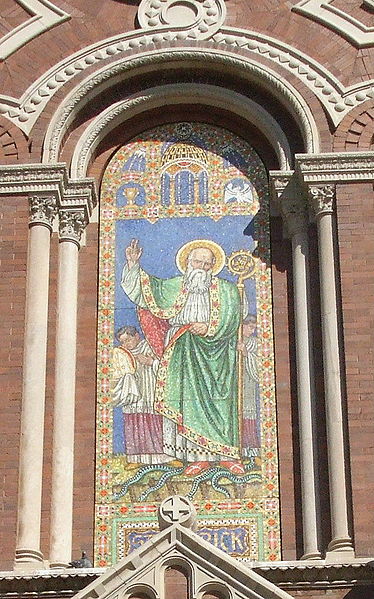
As the serpent that wrapped around the Tree of Knowledge in the Garden of Eden was the one who tried to tempt Adam and Eve, so was the bronze serpent that Moses raised in the desert a symbol of the Messiah who was to come.
This serpent swallowed all of the Egyptian sorcerers’ small snakes. Jesus advised his disciples to be as cautious as serpents and as nice as doves. Therefore, it is clear that the serpent was seen as a symbol of both good and evil in popular Jewish tradition at the time. The serpent served as the hero’s defender as a representation of wisdom and the power that comes from profound knowledge.
Because wisdom upholds, protects, and overshadows its chosen sons, the priests of the mystery religions were bestowed with the symbol of wisdom and eventually came to be seen as its embodiment. If the serpent is a symbol of both good and evil, this must speak to wisdom’s dual nature as both a preserver and a destroyer.
By extension, the serpent is connected with the principle of mind and all of man’s intellectual achievements. We already know that the mind, depending on how its powers are applied, may either progress or limit man’s destiny. Agathodaemon (in Greek: “ἀγαθός δαίμων”, meaning “noble spirit”), the beneficent snake, is represented by the serpent standing erect. It stands for the ascendance of the serpent force in the sixth ventricle of the spinal cord in Indian culture.
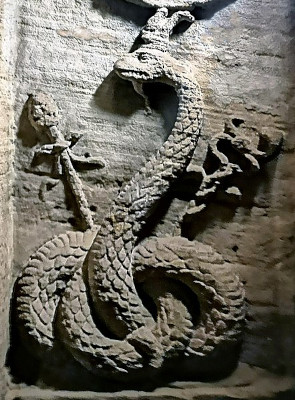
The fallen serpent represents the material mind, which is forced to eat dust as a result of luring man away from the path of righteousness. The intellect is the most subtle of man’s abilities, and the serpent is the most subtle of all creatures. When the intellect is engaged in the pursuit of real wisdom, it transforms into a saving and redemptive force. If, on the other hand, it is bound to material concerns, it leads to ideas and conspiracies and forces people to live in delusion.
The Plains Indians of the United States say that someone who does not speak the truth speaks with a divided tongue, referring to the snake’s forked tongue. Thus, the serpent appears in the common form of the deceiver among these tribes. This also applies to the intellect, which frequently deceives people via false and selfish reasoning.
There are also hints of a whole other form of symbolism in which the serpent becomes associated with regeneration. The ancients noticed that the snake lost its skin and thus regenerated annually from its own body. It was reborn and so accurately represented the resurrection. Man is always being born again from his old nature. Knowledge expansion is a form of rebirth—a release from previous constraints and development toward a higher state.
The phallic meaning of the serpent in dreams and psychological drawings has also been widely examined in psychology. The serpent’s movement distinguishes it from other species. It does not walk or crawl; instead, it glides with elegant body undulations. This flowing motion was compared to the movement of free energy in space, and its rhythmic waves made people think of the basic motion of things.
Related reading: Unlocking the Secrets of the Ankh ☥ – Opens in new tab
The serpent took on the shape of the dragon in China, which was undoubtedly a symbol of cosmic force. It was also a creature that did not get its energy from the earth itself. It was a space entity, thus it was related to awareness and those spiritual aspects of the human person that had a life and existence in eternity.
The rhythms of the cosmos, which were equivalent to Pythagorean “music of the spheres,” had a significant impact on Oriental peoples. They also related the serpent to the moon’s eccentric orbit around the Earth. The most northern and southern nodes of the moon were referred to as “the head and tail of the serpent, or dragon.” It was only logical for this to lead to a relationship between the serpent and the notion of time.
According to “The Hieroglyphics of Horapollo” (aff.link) (authored by an Egyptian magus, Horapollo Niliacus), the serpent with its tail in its mouth (ouroboros) was considered to be the symbol of eternity among the Egyptians. The Aztec Zodiac signs are scattered on the body of a serpent in the so-called Mexican calendar stone. This is the sky serpent shown in the Dresden Codex, from whose mouth the waters of the flood flow.
To the Druids, a serpent curled around an egg indicated the earth’s magnetic bands. Great saviors and philosophers were thought to be born from serpent eggs.
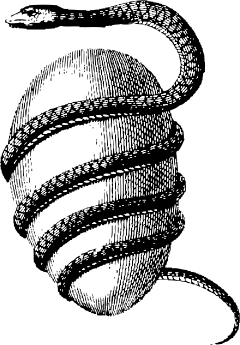
As a result, it is obvious that context as well as the general religion or philosophy of the society involved will have a significant impact on the accurate interpretation of a serpent figure in symbolism. Many ideologies, obviously, do not consider the human mind to be a source of evil, nor do they accept the notion of original sin. In such cases, the serpent is depicted as a constructive symbol of wisdom and comprehension.
The ancients, for example, connected the sign of Scorpio with three distinct parts, all of which were intimately related to creative power. The lowest of them was the scorpion, which stung with its tail; the next was the serpent, which carried its venom in its mouth; and the third was the eagle, which was probably originally a phoenix. The scorpion, as the “back-biter,” became connected with deception; the serpent, with erudition, or the regenerative power of the sign; and the eagle, or phoenix, with enlightenment, or spiritual insight into divine things.
Even in psychology, the serpent has a clear meaning that can be deduced from its associations with other symbols. It can signify mystery, terror, or even disgust in certain instances, as well as creation or regeneration, a discharge of life, or even human sperm in others. Because man is so unsure about the fundamental natures of good and evil, he perpetuates this ambiguity through the means of this amazing symbol.
Check out our recommendations at “Occult Bookshelf” and many free resources at our “Free Library“
Stay in Touch
 Join our newsletter by using the forms on this website or click here!
Join our newsletter by using the forms on this website or click here! Follow us on Google News
Follow us on Google News Follow us on Facebook
Follow us on Facebook
Featured Image by Graham Hobster from Pixabay

